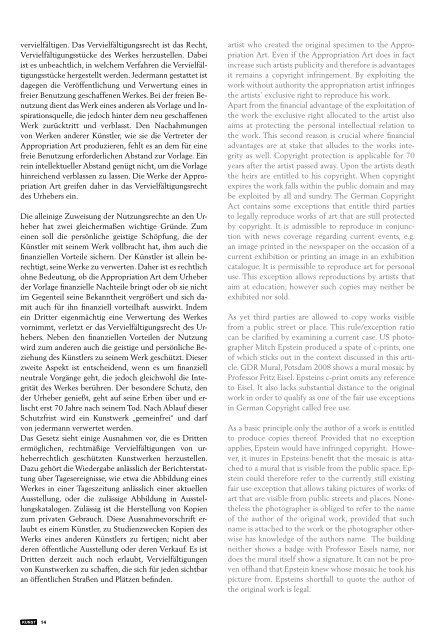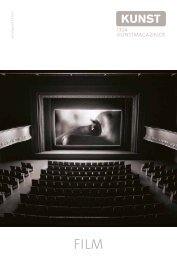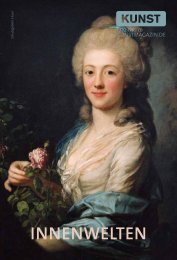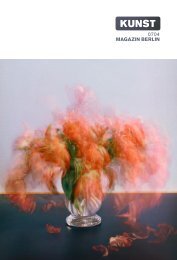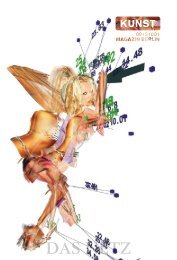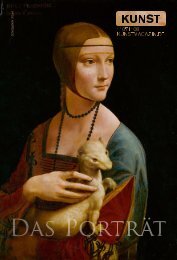CRIME TIME - KUNST Magazin
CRIME TIME - KUNST Magazin
CRIME TIME - KUNST Magazin
Sie wollen auch ein ePaper? Erhöhen Sie die Reichweite Ihrer Titel.
YUMPU macht aus Druck-PDFs automatisch weboptimierte ePaper, die Google liebt.
vervielfältigen. Das Vervielfältigungsrecht ist das Recht,<br />
Vervielfältigungsstücke des Werkes herzustellen. Dabei<br />
ist es unbeachtlich, in welchem Verfahren die Vervielfältigungsstücke<br />
hergestellt werden. Jedermann gestattet ist<br />
dagegen die Veröffentlichung und Verwertung eines in<br />
freier Benutzung geschaffenen Werkes. Bei der freien Benutzung<br />
dient das Werk eines anderen als Vorlage und Inspirationsquelle,<br />
die jedoch hinter dem neu geschaffenen<br />
Werk zurücktritt und verblasst. Den Nachahmungen<br />
von Werken anderer Künstler, wie sie die Vertreter der<br />
Appropriation Art produzieren, fehlt es an dem für eine<br />
freie Benutzung erforderlichen Abstand zur Vorlage. Ein<br />
rein intellektueller Abstand genügt nicht, um die Vorlage<br />
hinreichend verblassen zu lassen. Die Werke der Appropriation<br />
Art greifen daher in das Vervielfältigungsrecht<br />
des Urhebers ein.<br />
Die alleinige Zuweisung der Nutzungsrechte an den Urheber<br />
hat zwei gleichermaßen wichtige Gründe. Zum<br />
einen soll die persönliche geistige Schöpfung, die der<br />
Künstler mit seinem Werk vollbracht hat, ihm auch die<br />
finanziellen Vorteile sichern. Der Künstler ist allein berechtigt,<br />
seine Werke zu verwerten. Daher ist es rechtlich<br />
ohne Bedeutung, ob die Appropriation Art dem Urheber<br />
der Vorlage finanzielle Nachteile bringt oder ob sie nicht<br />
im Gegenteil seine Bekanntheit vergrößert und sich damit<br />
auch für ihn finanziell vorteilhaft auswirkt. Indem<br />
ein Dritter eigenmächtig eine Verwertung des Werkes<br />
vornimmt, verletzt er das Vervielfältigungsrecht des Urhebers.<br />
Neben den finanziellen Vorteilen der Nutzung<br />
wird zum anderen auch die geistige und persönliche Beziehung<br />
des Künstlers zu seinem Werk geschützt. Dieser<br />
zweite Aspekt ist entscheidend, wenn es um finanziell<br />
neutrale Vorgänge geht, die jedoch gleichwohl die Integrität<br />
des Werkes berühren. Der besondere Schutz, den<br />
der Urheber genießt, geht auf seine Erben über und erlischt<br />
erst 70 Jahre nach seinem Tod. Nach Ablauf dieser<br />
Schutzfrist wird ein Kunstwerk „gemeinfrei“ und darf<br />
von jedermann verwertet werden.<br />
Das Gesetz sieht einige Ausnahmen vor, die es Dritten<br />
ermöglichen, rechtmäßige Vervielfältigungen von urheberrechtlich<br />
geschützten Kunstwerken herzustellen.<br />
Dazu gehört die Wiedergabe anlässlich der Berichterstattung<br />
über Tagesereignisse, wie etwa die Abbildung eines<br />
Werkes in einer Tageszeitung anlässlich einer aktuellen<br />
Ausstellung, oder die zulässige Abbildung in Ausstellungskatalogen.<br />
Zulässig ist die Herstellung von Kopien<br />
zum privaten Gebrauch. Diese Ausnahmevorschrift erlaubt<br />
es einem Künstler, zu Studienzwecken Kopien des<br />
Werks eines anderen Künstlers zu fertigen; nicht aber<br />
deren öffentliche Ausstellung oder deren Verkauf. Es ist<br />
Dritten derzeit auch noch erlaubt, Vervielfältigungen<br />
von Kunstwerken zu schaffen, die sich für jeden sichtbar<br />
an öffentlichen Straßen und Plätzen befinden.<br />
14<br />
artist who created the original specimen to the Appropriation<br />
Art. Even if the Appropriation Art does in fact<br />
increase such artists publicity and therefore is advantages<br />
it remains a copyright infringement. By exploiting the<br />
work without authority the appropriation artist infringes<br />
the artists’ exclusive right to reproduce his work.<br />
Apart from the financial advantage of the exploitation of<br />
the work the exclusive right allocated to the artist also<br />
aims at protecting the personal intellectual relation to<br />
the work. This second reason is crucial where financial<br />
advantages are at stake that alludes to the works integrity<br />
as well. Copyright protection is applicable for 70<br />
years after the artist passed away. Upon the artists death<br />
the heirs are entitled to his copyright. When copyright<br />
expires the work falls within the public domain and may<br />
be exploited by all and sundry. The German Copyright<br />
Act contains some exceptions that entitle third parties<br />
to legally reproduce works of art that are still protected<br />
by copyright. It is admissible to reproduce in conjunction<br />
with news coverage regarding current events, e.g.<br />
an image printed in the newspaper on the occasion of a<br />
current exhibition or printing an image in an exhibition<br />
catalogue. It is permissible to reproduce art for personal<br />
use. This exception allows reproductions by artists that<br />
aim at education; however such copies may neither be<br />
exhibited nor sold.<br />
As yet third parties are allowed to copy works visible<br />
from a public street or place. This rule/exception ratio<br />
can be clarified by examining a current case. US photographer<br />
Mitch Epstein produced a spate of c-prints, one<br />
of which sticks out in the context discussed in this article.<br />
GDR Mural, Potsdam 2008 shows a mural mosaic by<br />
Professor Fritz Eisel. Epsteins c-print omits any reference<br />
to Eisel. It also lacks substantial distance to the original<br />
work in order to qualify as one of the fair use exceptions<br />
in German Copyright called free use.<br />
As a basic principle only the author of a work is entitled<br />
to produce copies thereof. Provided that no exception<br />
applies, Epstein would have infringed copyright. However,<br />
it inures in Epsteins benefit that the mosaic is attached<br />
to a mural that is visible from the public space. Epstein<br />
could therefore refer to the currently still existing<br />
fair use exception that allows taking pictures of works of<br />
art that are visible from public streets and places. Nonetheless<br />
the photographer is obliged to refer to the name<br />
of the author of the original work, provided that such<br />
name is attached to the work or the photographer otherwise<br />
has knowledge of the authors name. The building<br />
neither shows a badge with Professor Eisels name, nor<br />
does the mural itself show a signature. It can not be proven<br />
offhand that Epstein knew whose mosaic he took his<br />
picture from. Epsteins shortfall to quote the author of<br />
the original work is legal.


